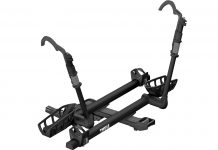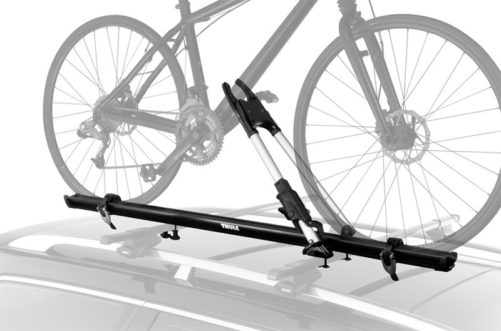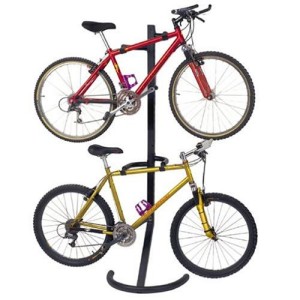Most of the bike racks that we review and write about on this website are mounted to an SUV, car or truck. There are other bike racks out there that we also want to discuss and review…
“Specialty bike racks” are bike racks that are do not mount to the roof, trunk or hitch. In fact, they may not mount to a vehicle at all. They may be attached to the wall in your garage or shed and they may even be free standing in your driveway.
Here is a list of some of these types of bike racks, we like to call “specialty”.
Truck Bed Bike Racks
Several types of bike racks are designed to fit into a pickup truck bed.
A rack that attaches one bicycle to the bottom, side, or bed liner of a pickup truck typically costs between $50-$150. Some of these racks can be extended to add more bikes.
Many advertise that they fit securely into the truck without drilling. One type of simple, though expensive, the truck bed bike rack is basically an expandable rod (like a shower rod) that presses itself against the sides of the truck bed.
Other truck bed bike racks are anchored by bolts that fit into the truck bed and may be compatible with only certain types of trucks. Some fit into grooves in the truck bed.
Truck Bed Cover Bike Racks
Bike racks can be installed on the cover of a truck bed, if it has one. Truck bed tonneau covers are brand-specific; they have to fit a specific model of pickup truck. Bikes may be anchored to crossbars or into racks on the top of the cover.
Camper Bike Racks
RV bumper bike racks, which attach to the rear bumper of a recreational vehicle, can store two or more bicycles outside the camper. The obvious advantage is that the bikes don’t take up space, or slide around, inside the camper; the disadvantage is that they add two to four feet to the length of a vehicle that’s already pretty long.
Spare Tire Bike Racks
If a truck or RV has a rear-mounted spare tire, a rack that will hold one or two bicycles can be fitted over the spare tire cover. These racks can be light, cheap, and simple.
Tent Trailer Bike Racks
Those tent trailers that can be hitched onto the backs of some RVs can also support bike racks. For $500 to non-members (less for members) Pro Rack offers a metal fork-mounted rack that holds up to four bikes.
RV and Trailer Roof Racks
“Pop-up” bike racks can be attached to RV or trailer roofs, just like car roofs. Some DIY enthusiasts just add a rubber mat to the roof, tie the bikes on, and feel ready to roll.
Metal racks with tracks and crossbars hold bicycles in a vertical position that is safer for the bikes, as long as there’s enough headroom above the RV.
Over the Ladder Bike Racks
Adding a bike rack to an RV that has a ladder is simple. A plastic-coated steel bar that fits over the rungs of an RV ladder can hold bicycles, chairs, or other camping gear, for less than $20.
A more elaborate aluminum rack that attaches to the ladder with pins is a little more expensive.
Free Standing Bike Racks
These are used for “parking” bicycles outdoors. They come in a variety of styles. A two-bike “hanger” secures two bicycles to one post; this cheap and simple option works where space is limited.
Racor makes a four-bike hanger, that will hold up to four forty-pound bikes, for about $120.
Traditional free standing bike racks anchor the front of the bicycle in a vertical track–usually between metal bars, although a recycled plastic rack that will hold ten bikes is available for just under $500. More conventional metal stands for five to ten bikes cost $100 or less.
“Wave” bike racks allow the front or center of the bicycle to be tied or chained to a single post. Considered an innovative look in the 1980s, these racks are similar in size, use, and cost to the traditional racks.
(If they had an advantage, it’s that substituting posts for tracks reminded people to lock up their bikes.)
A real innovation that might be useful in some places is the “Crank It Up” one-bike stand. For long-term outdoor storage, “Crank It Up” lifts the bike’s tires above the ground, protecting wheels and tires from water damage.
Free standing four-bike racks can be transferred easily between ground, floor, and truck bed, and are designed to fit neatly across most pickup truck beds.
Bicycle Repair Racks
Although they can, of course, be used for storage, racks that lift a bicycle a few feet above the floor were designed to make repairs and maintenance easier.
The post to which the bicycle is fastened may swing up and down with the bike; there may be a seat and even places to hang tools and accessories, for the convenience of the person repairing the bike.
Wall Mounted Bike Racks
Designed for indoor storage, these racks are most useful for keeping bicycles from falling over in limited closet or hallway space. A simple, shelf-type, one-bike holder that folds flat against the wall when not in use costs about $15.
A simple vertical bike rack that holds up to six bikes (if the wall can take that much weight) costs less than $100. A fancier vertical bike rack that holds two or three bikes, but allows them to be turned almost flat against the wall, and anchors the top wheel of each bike to the bottom of a shelf designed to hold helmets and gear, costs $239 to $269.
Decorative indoor wall mounted bike racks are available online. There’s a “minimalist” version (a pair of wooden pegs to attach to the wall) and some clever designer looks, like the “Bookbikeshelf,” a tall, narrow bookshelf with a vertical bike rack on the side.
Ceiling Mounted Bike Racks
Probably most often seen at bike shops, ceiling mounted racks are used for displaying, repairing, and storing bicycles. A four-bike ceiling mounted storage rack for home use may cost $250.
New specialty bike racks are designed every year to meet new bicycle display, storage, and transport requirements, so watch this space for updates on specialty bike racks.










